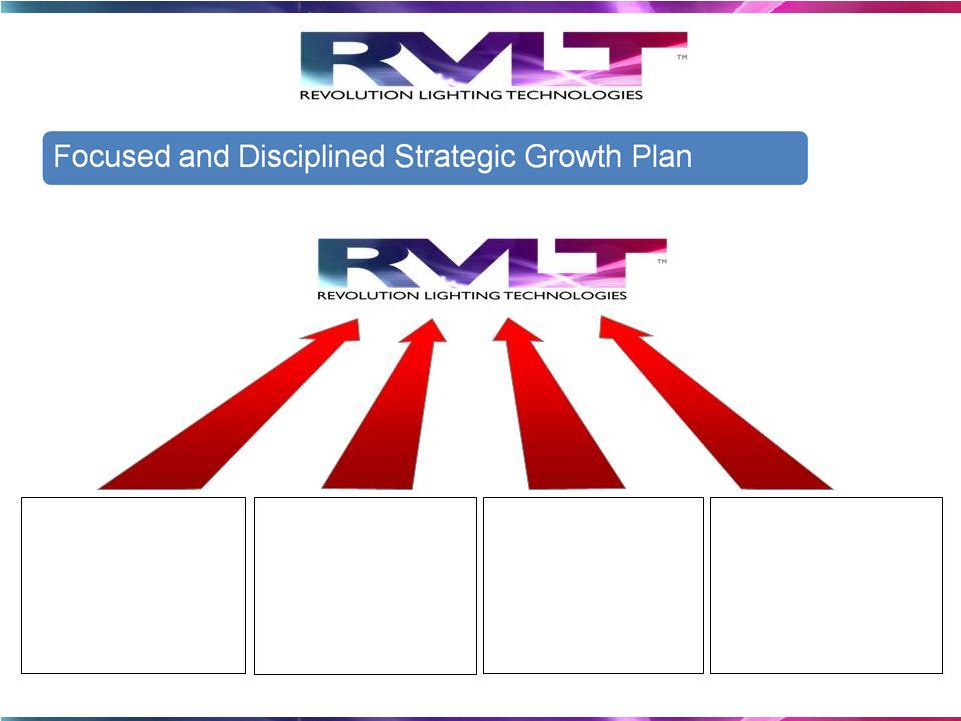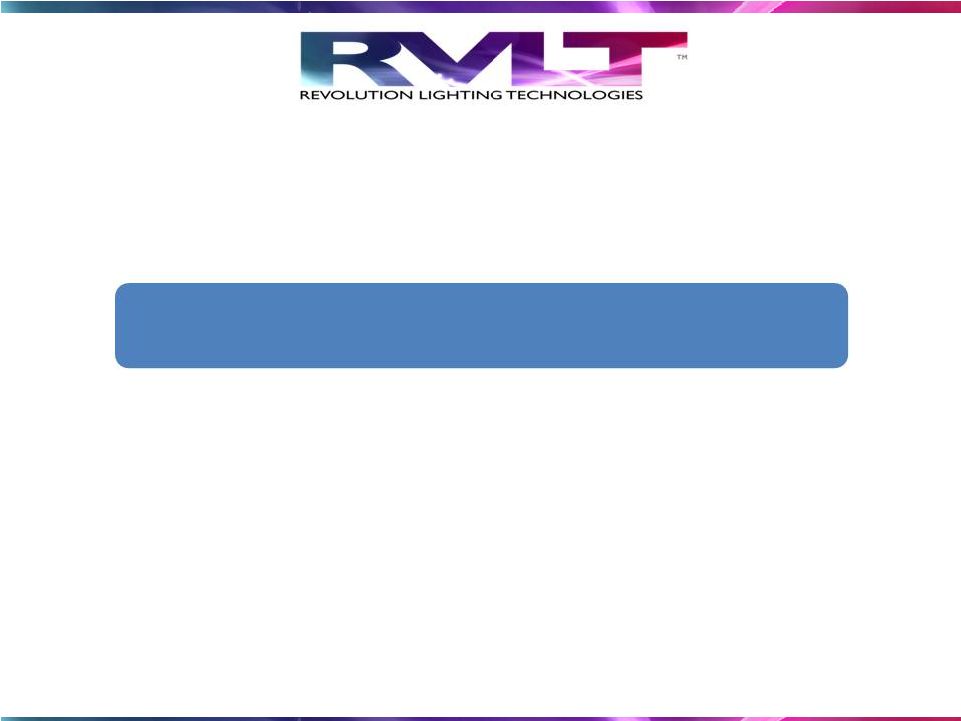Attached files
| file | filename |
|---|---|
| 8-K - FORM 8-K - Revolution Lighting Technologies, Inc. | d603647d8k.htm |
 Craig-Hallum Alpha Select Conference
September 26, 2013
Exhibit 99.1 |
 Forward-Looking Information
All statements, other than statements of historical fact,
contained in this
presentation are forward-looking statements that involve a number of risks
and uncertainties, including any information as to the future
financial or operating performance of the Company. Such forward-looking
statements are within the meaning of that term in Section 27A of the
Securities Act of 1933 and Section 21E of the Securities Exchange Act of
1934. Reference is made to the Company’s filings under the Securities
Exchange Act for additional factors that could cause actual results to
differ materially, including the Risk Factors described in Item 1A of our
Form 10-K for the fiscal year ended December 31, 2012. The Company
undertakes no obligation to publicly update or revise any
forward-looking statements, whether as a result of new information,
future events, or otherwise. Readers are cautioned that any such
forward-looking statements are not guarantees of future performance and
involve risks and uncertainties, and that actual results may differ
materially from those indicated in the forward- looking statements as a
result of various factors. Readers are cautioned not to place undue reliance
on these forward-looking statements. 2 |
 3
Strategic Vision
Investment Highlights and Differentiators
LED Market Opportunity and Drivers
Our Brand and Products
Growth Strategy
Financials
Summary |
 4
•
Leader in LED Lighting Solutions:
•
Innovative
•
Energy Efficient
•
Cost Effective
•
Growth Plan
•
Midsize/Large Commercial and Industrial Installations
•
Higher Margin Opportunities
•
Focus on Verticals with Higher Adoptions and Growth
•
Technology Investments
•
State of the Art Products
•
Enhance Quality and Performance
•
Highest Standards of Customer Service
Strategic Vision |
 5
Investment Highlights and Differentiators
•
Pure play LED platform with a leading end-to end offering
•
Multi-Brand
•
Product Breadth
•
Global
•
High growth company with strong financial profile
•
Organic growth of > 50%
•
35% Plus gross margins
•
EBITDA margins 15% plus
•
Top flight management team
•
Winning track record
•
Strong financial partners
•
Aston Capital/Light Cap Fund
|
 6
•
Unique marketing network to address a $1.5 billion pipeline
•
Exclusive Distributors/Dealers
•
Industry focused Marketing Experts
•
Sales reps/Agencies
•
ESCOS
•
Blue chip relationships and installed base poised for long
term growth
Investment Highlights and Differentiators |
 7
Market Vertical
Over $150 Million in addressable opportunities over the next 3 to 12 Months
3-12 Month Targets
Illustrative Clients
Municipalities and Government
(State and Local)
Municipalities: $15M
Government: $12M
Municipality A: $5M
Municipality B: $3M
Government A: $5M
Government B: $3M
Universities & Public Schools
Universities: $25M
Public Schools: $20M
School A: $9M
School B: $6M
School C: $5M
Others: $20M ($1M-$3M Each)
Gaming / Hotels / Shopping / Others
Gaming Industry: $30M
Hotels / Other: $6M
Gaming A: $15M
Gaming B: $5M
Others: $16M ($1M Each)
Real Estate Managers and
Developers
$25M Target
Customer A: $15M
Customer B: $5M
Others: $16M ($1M -
$2M Each)
Healthcare & Others
Healthcare: $6M
Maritime: $3M
Maritime A: $2M
Healthcare A: $2M
Others: $5M |
 8
Source: McKinsey & Company Report Dated 2011
LED Market Opportunity
Key LED Adoption Drivers
•
LED lights represent 18% of the $66 billion global lighting
market
•
LED share expected to account for 70% of $100 billion
market by 2020
•
Significant energy efficiency and cost savings •
80% more efficient than traditional lighting •
Government legislation mandating transition •
Energy Independence and Security Act of 2007 enacted to
facilitate the transition to LEDs |
 9
Our Brands and Products |
 10
Key Differentiator: Technology/Price Performance/Product Performance
Focus on Indoors (Tubes, High Bays,
PARs, Sport Lights, Household Bulbs)
Indoor Product Portfolio |
 Before
After
11
Case Study________________
Case Study: |
 Before
After
12
Case Study: |
 13
Key Differentiator: Technology/Product Performance
Media and Signage
Media and Signage |
 14
Key Differentiator: Technology/Product Performance
Garages,
Floodlighting,
Canopy,
Street
Lights,
Wall
Packs |
 Before
After
15
Case Study: |
 Before
After
16
Case Study: |
 Key
Differentiator: Technology/Price Performance 17 |
 18
Source: Company
Management Assessment
Competitive Positioning in LED Markets |
 19
|
 CURRENT
CUSTOMERS •
•
EXPAND DISTRIBUTION
•
•
CORPORATE ACCOUNTS
•
•
ACQUISITIONS
•
•
•
20
Opportunity to increase
revenue per customer
Revenue drivers per
vertical market
Direct, distribution
partners and industry
agencies
Pull through model with
distribution supporting
lighting agents
Dedicated team with prior
industry experience
Significant pipeline of
prospects
Fragmented market with
opportunities
Related, products and add-
on services
Synergies in purchasing,
routing and expenses |
 21
•
$5M to $50M in revenue
•
Unique product; intellectual property or manufacturing advantages
•
Leverage Dealer/Distributor Network
•
Products that provide cost advantages or fill voids
•
Control systems
•
Signage products
•
Architectural products
Related Business
Typical acquisition target
Acquisition Strategy |
 22
Financial Discussion |
 23
Strong Financial Profile
YOY Organic Growth: > 100%
2013 Bridge (Pro Forma*) *Gives effect to
the acquisitions of Seesmart and Relume as if such acquisition had occurred in January 1, 2012
**1st half 2013 contains a single $9M order
Millions Revenue
Gross Margin
35%
37%
21%
1st Half of
2013**
2nd Half of
2013
Full Year
2013
Full Year
2012
40%
$17.6M
$17M
$35M
$18.5M
0
5
10
15
25
30
35
40
20 |
 24
Strong Financial Profile
3 Year View
*See adjusted EBITDA reconciliation
FY 2012-14 CAGR : 65%
70
60
50
40
30
20
10
0
-10
-20
Full Year 2012
Full Year 2013
Preliminary 2014
Sales
Adjusted EBITDA
Gross Margin
>$7M
-$3M*
-$12M*
-$12M*
$18.5M
$34M
>$50M
21%
37%
39% |
 Target Model
FY 2013 Estimated
Preliminary FY
2014 –
2016 Target Model
Organic Growth %
100%
>50%
Gross Margin %
37%
35%+
Operating Expenses %
47%
20%
Adjusted EBITDA
Margins %
N/A
15%+
25 |
 26
Summary
Differentiated Business Model
Unique platform with end-to-end solutions
Powerful sales and distribution engine
Built strong foundation to capture near term meaningful market shares
Significant organic growth targeted > 50
Strong Foundations
Above industry gross margins (35% +)
Focused and Disciplined acquisition strategy
Proven Management Team
Large Addressable Market
Track record of delivering growth and return to shareholders
Actionable $1.5 billion pipeline with over $150 million in near term
opportunities |
 27
(in millions)
Year Ended
December 31, 2012
For the 6
Months ended
June 30, 2013
Net Loss
$
(20.0)
$
(12.8)
Change in Fair value of embedded derivative
—
7.0
Gain on bargain purchase of business
—
(0.7)
Severance, transition and related costs
2.4
2.7
Depreciation and amortization and stock compensation costs
3.0
3.1
Interest
0.2
Gain on restructuring of debt
(1.0)
Impairment charge
3.4
Adjusted EBITDA
$
(12.0)
$
(0.7)
Adjusted EBITDA
We used Adjusted EBITDA as a non-GAAP measure of financial performance. Adjusted
EBITDA is calculated by adding back to net income or loss interest and financing
related transactions, acquisition related transactions, income taxes, depreciation and amortization, asset impairments, stock based compensation
charges, and severance and transition costs. Adjusted EBITDA is provided to investors to
supplement the results of operations reported in accordance with GAAP. Management
believes that Adjusted EBITDA is useful to help investors analyze the operating trends in the business and to assess the relative underlying
performance of businesses with different capital and tax structures. Management believes
that Adjusted EBITDA provides an additional tool for investors to use in comparing our
financial results with other companies that use Adjusted EBITDA in their communications with investors By impairments as well as as non
operating charges for income taxes, interest and financing charges, acquisition related and
severance and transition costs charges investors can evaluate our operations and
compare our results with the results of other companies on a more consistent basis. Management also uses Adjusted EBITDA to evaluate potential
acquisitions, establish internal budget and goals and evaluate the performance of business
units and management. We consider Adjusted EBITDA to be an important indicator of our
operational strength and performance and a useful measure of historical and prospective trends
However there are significant limitations of the use of Adjusted EBITDA since it excludes
interest income and expenses, financing related and acquisition related transactions
and severance and transition costs, income taxes, all of which impact profitability, as well as depreciation and amortization related to the use of long
lived assets that benefits future periods. We believe that limitations are compensated
by providing Adjusted EBITDA only with GAAP performance measures and clearly
identifying the differences between the two measures. Consequently, Adjusted EBITDA should not be considered in isolation or as a substitute for net
income or loss or operating income or loss presented in accordance with GAAP. Moreover,
Adjusted EBITDA as defined by the Company may not be comparable to similarly titled
measure provided by other entities. A reconciliation of our proforma GAAP net loss to
our proforma non-GAAP Adjusted EBITDA for the year ended December 31, 2012 and six months ended June 30,
2013, respectively follows. It is not practicable to prepare a reconciliation for the
prospective periods ending December 31, 2012 and 2013. |
